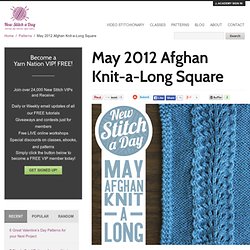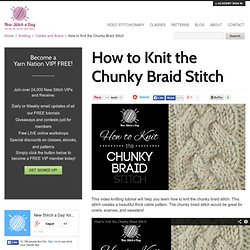

Learn To Knit – Let’s Knit Magazine. Learn to Knit Video Tutorials for Beginners to Advanced Knitters. May 2012 Afghan Knit-a-Long Square NewStitchaDay. The New Stitch a Day Afghan Knit-and-Crochet-a-Long is a year long project that will challenge you to try out some of the patterns we have here on the site.

Each month we will alternate between a knitted and a crochet pattern and turn it into a 12″x12″ square. At the end of the year you will have 12 (or more) unique afghan squares you can use to make a beautiful blanket. The May 2012 New Stitch Afghan Knit-a-long square was created by one of our viewers, Rachel Powell! It uses the Ostrich Plume Stitch to create an gorgeous panel with lace accents. Material 1 skein Vanna’s Choice 3.5 oz (100 g), 170 yards (156 m) 100% Acrylic color shown: Dusty Blue or any worsted weight yarn 1 pair of size US 9 (5.5 mm) knitting needles tapestry or darning needle Finished Size 12″ x 12″ Gauge 16 stitches x 22 rows = 4″ (10 cm) on size 9 (5.5 mm) needles Pattern Instructions Cast on 55 stitches Knit 5 rows Row 1: k3, p7, k13, p9, k13, p7, k3 Row 2: k10, p13, k9, p13, k10 Row 4: k10, p13, k9, p13, k10.
How to Knit the Chunky Braid Stitch NewStitchaDay. This video knitting tutorial will help you learn how to knit the chunky braid stitch.

This stitch creates a beautiful thick cable pattern. The chunky braid stitch would be great for cowls, scarves, and sweaters! Sourced the softest wool WEBS could find and dyed in a beautiful collection of solid colors and heathered shades. It is a dream to felt and soft enough for cozy garments. Valley Yarns Northampton also has a whopping 247 yards per skein. Knit Picks Tutorials. Learn to Knit: Lion Brand Yarn. Video Library: Online videos about Knitting. Knit Purl Hunter Video Lessons. Learn to Knit the Basics. If you're a beginning knitter, you can start with our 45 minute "How to Knit" series.

This 3 part introduction to knitting walks the new knitter step-by-step through the knitting basics: Long Tail cast-on and the knit and purl stitches and basic knit bind-off and finishing your knitting. Along the way you'll pick up many knitting tips and guidance on how to identify and fix common knitting mistakes. If you're already familiar with the craft and just need a quick refresher, take a look at the "There's a lot more to KnittingHelp.com" section below.
The site is divided into primary techniques, as well as knitting tips, advanced knitting techniques and knitting abbreviations. What to knit first? A scarf is the most common first project. For more ideas, take a look at our free pattern directory. Warning: If you make a scarf in the lovely stockinette stitch (alternating a knit row with a purl row), the side edges will curl in.
Yarn and Needles: Verypink.com video tutorials. Learn to Knit Socks. Knitting Cable Stitches. Knitting Cables. The simple technique of cabling (crossing one group of stitches over another) lends itself to many interpretations in knitting.

It's easy to do, you can make all kinds of interesting and imaginative cable patterns. All it takes is a little patience and practice. You can make any kind of cable by suspending (holding) a number of stitches on a cable needle (cn) while you knit that same number of stitches from the LH needle. Then you knit the suspended stitches either by returning them to the LH needle and knitting them or by knitting them straight from the cable needle. This process of knitting stitches out of order enables you to cross stitches, creating cables. Standard or rope cables are the most basic cables. If you want to make a cable that looks like it's twisting to the left, you hold your suspended stitches in front of your work while you knit from the LH needle.If you want to make a cable that twists to the right, hold the suspended stitches in back.
Video Stitchionary NewStitchaDay. Learn to Knit Socks. How To Knit. Vogue Knitting. How to Use Stitch Markers. July 25th, 2011 by Jess Stitch markers are essential tools to crocheters and knitters alike.

They can be used to mark a certain number of stitches, the beginning of a round, where to make a particular stitch, and more. Patterns often call for stitch markers with the abbreviations “pm” (place marker) and “sm” (slip marker). It’s important to note that there are essentially two categories of stitch markers: closed and open (also known as split-ring). As the name implies, closed stitch markers feature one solid loop. While knitting, the stitch marker sits on the needle between active stitches. Closed stitch markers do not work with most crocheting techniques. Open or split-ring markers are incredibly versatile.
When knitting, these markers can be used on the needle (as with closed markers) or attached to particular stitches. Because they can be removed at any time, open stitch markers are perfect for attaching to crochet stitches. Knit Simple Magazine.